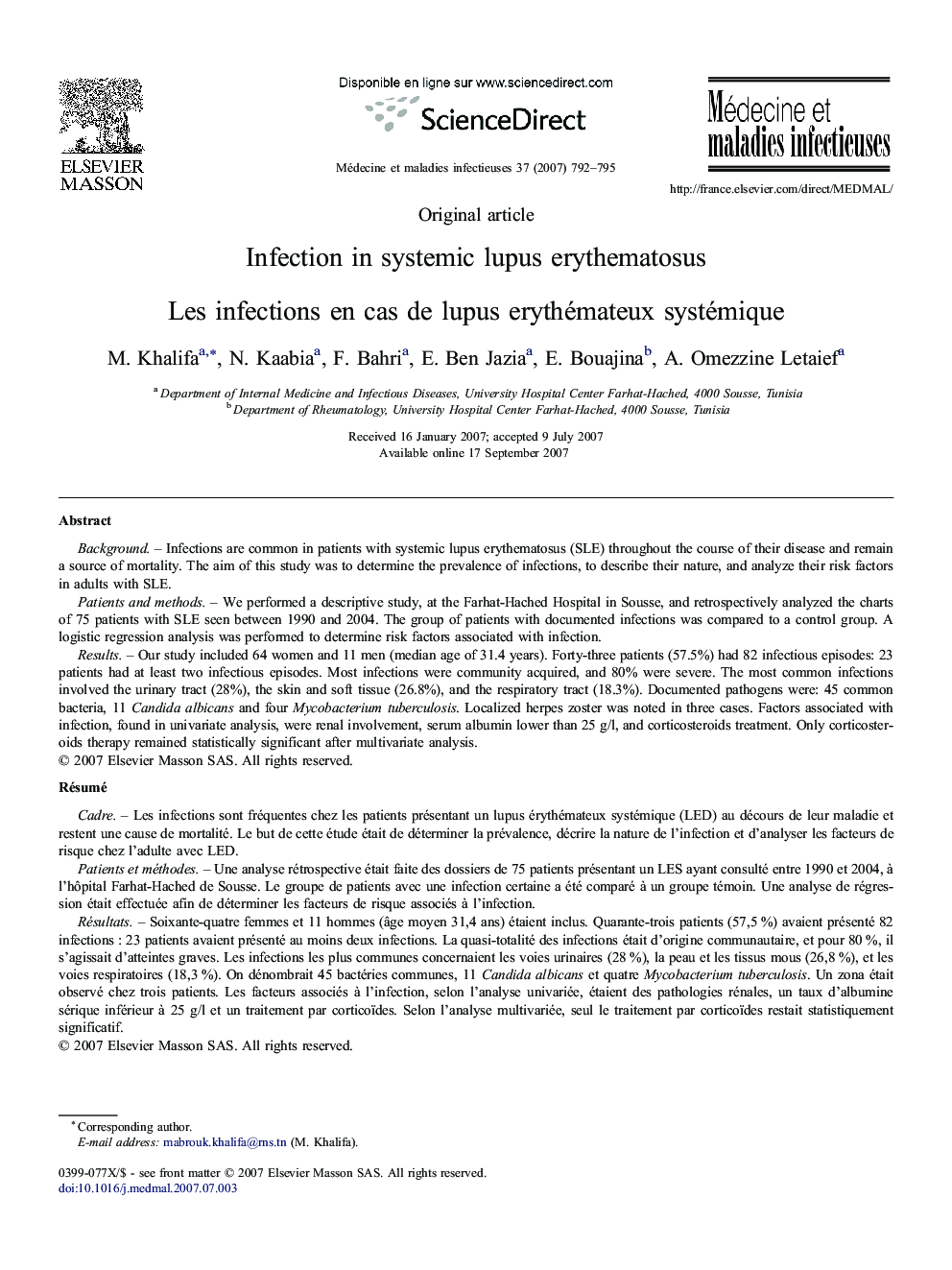| Article ID | Journal | Published Year | Pages | File Type |
|---|---|---|---|---|
| 3414142 | Médecine et Maladies Infectieuses | 2007 | 4 Pages |
BackgroundInfections are common in patients with systemic lupus erythematosus (SLE) throughout the course of their disease and remain a source of mortality. The aim of this study was to determine the prevalence of infections, to describe their nature, and analyze their risk factors in adults with SLE.Patients and methodsWe performed a descriptive study, at the Farhat-Hached Hospital in Sousse, and retrospectively analyzed the charts of 75 patients with SLE seen between 1990 and 2004. The group of patients with documented infections was compared to a control group. A logistic regression analysis was performed to determine risk factors associated with infection.ResultsOur study included 64 women and 11 men (median age of 31.4 years). Forty-three patients (57.5%) had 82 infectious episodes: 23 patients had at least two infectious episodes. Most infections were community acquired, and 80% were severe. The most common infections involved the urinary tract (28%), the skin and soft tissue (26.8%), and the respiratory tract (18.3%). Documented pathogens were: 45 common bacteria, 11 Candida albicans and four Mycobacterium tuberculosis. Localized herpes zoster was noted in three cases. Factors associated with infection, found in univariate analysis, were renal involvement, serum albumin lower than 25 g/l, and corticosteroids treatment. Only corticosteroids therapy remained statistically significant after multivariate analysis.
RésuméCadreLes infections sont fréquentes chez les patients présentant un lupus érythémateux systémique (LED) au décours de leur maladie et restent une cause de mortalité. Le but de cette étude était de déterminer la prévalence, décrire la nature de l'infection et d'analyser les facteurs de risque chez l'adulte avec LED.Patients et méthodesUne analyse rétrospective était faite des dossiers de 75 patients présentant un LES ayant consulté entre 1990 et 2004, à l'hôpital Farhat-Hached de Sousse. Le groupe de patients avec une infection certaine a été comparé à un groupe témoin. Une analyse de régression était effectuée afin de déterminer les facteurs de risque associés à l'infection.RésultatsSoixante-quatre femmes et 11 hommes (âge moyen 31,4 ans) étaient inclus. Quarante-trois patients (57,5 %) avaient présenté 82 infections : 23 patients avaient présenté au moins deux infections. La quasi-totalité des infections était d'origine communautaire, et pour 80 %, il s'agissait d'atteintes graves. Les infections les plus communes concernaient les voies urinaires (28 %), la peau et les tissus mous (26,8 %), et les voies respiratoires (18,3 %). On dénombrait 45 bactéries communes, 11 Candida albicans et quatre Mycobacterium tuberculosis. Un zona était observé chez trois patients. Les facteurs associés à l'infection, selon l'analyse univariée, étaient des pathologies rénales, un taux d'albumine sérique inférieur à 25 g/l et un traitement par corticoïdes. Selon l'analyse multivariée, seul le traitement par corticoïdes restait statistiquement significatif.
